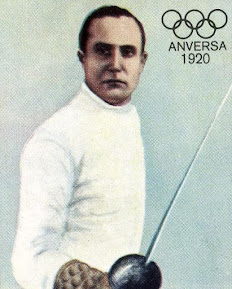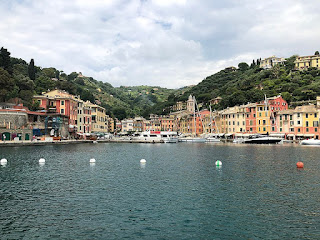NEW - Nedo Nadi - Olympic record-breaker
Five-medal haul at 1920 Antwerp Games included unique treble
Nedo Nadi, the Italian fencer regarded as among the greatest of all time, was born on this day in 1894 in Livorno, the port on the Tuscan coast. Born into a fencing family - his father, Giusepppe, was a renowned fencing master - Nadi won five gold medals at the 1920 Olympics in Antwerp, which remained the most by any athlete at a single Games until Mark Spitz won seven swimming titles in 1972. Nadi’s own distinction is that he was and still is the only fencer to have won a gold medal with all three weapons, winning the individual championship in both foil and sabre and a team gold in the épée. His quintuple of medals was completed with team golds in both the sabre and foil. His younger brother, Aldo, was also part of the winning Italian team in the épée and sabre events. Their total of seven golds is the most won by members of the same family at a single Games. Nedo’s historic achievement might never have happened if his father had had his way. Giuseppe believed the épée to be a “crude and undisciplined" weapon and refused to teach it, limiting the two brothers’ tuition to foil and sabre, to which they were introduced as children. Read more…
____________________________________
Luigi Cagnola - architect
Designer of Milan’s neoclassical Arch of Peace
The architect Luigi Cagnola, among whose most notable work the monumental Arco della Pace - Arch of Peace - in Milan stands out, was born in Milan on this day in 1762. The Arco della Pace, commissioned when Milan was under Napoleonic rule in 1807, can be found at Porta Sempione, the point at which the historic Strada del Sempione enters the city, about 2km (1.2 miles) northwest of the Duomo. Cagnola’s original commission a year earlier was for a triumphal arch for the marriage of Eugenio de Beauharnais, viceroy of the Kingdom of Italy, with Princess Amalia of Bavaria. The arch was made of wood, and not intended as a permanent structure, but Cagnola’s design was of such beauty that the Milan authorities asked him to reconstruct it in marble. His other major works include the Porta Ticinese, another of the main gates into Milan, the campanile - bell tower - of the church of Santi Nazario e Celso in Urgnano, a small town just outside Bergamo in Lombardy, the chapel of Santa Marcellina in Milan, the staircase of the Villa Saporiti in Como, and his own villa just outside Inverigo, the town to the southwest of Lake Como where Cagnola spent his final days. Read more…
_____________________________________
The death of Nero
Brutal emperor killed himself with help of aide
The Roman emperor Nero, whose rule was associated with extravagance and brutality, died on this day in 68 AD in what would now be described as an assisted suicide. Effectively deposed as emperor when simultaneous revolts in the Gallic and Spanish legions coincided with the Praetorian Guard rising against him, with Galba named as his successor, Nero fled Rome, seeking refuge from one of his few remaining loyalists. Phaon, an imperial freedman, gave him the use of a villa four miles outside Rome along Via Salaria, where he hastened, under disguise, along with Phaon and three other freedmen, Epaphroditos, Neophytus, and Sporus. Nero had hoped to escape to Egypt but realised there was no one left to provide the means and asked the four freedmen to begin digging his grave, in readiness for his death by suicide. In the meantime, the Senate had declared Nero a public enemy. As well as ordering the executions of numerous rivals, real or perceived, and even having his mother and two wives killed, Nero made many enemies through unpopular policies and confiscation of property. Read more…
______________________________________
Luigi Fagioli - racing driver
Man from Le Marche is Formula One's oldest winner
Racing driver Luigi Fagioli, who remains the oldest driver to win a Formula One Grand Prix, was born on this day in 1898 at Osimo, an historic hill town in the Marche region. Fagioli was a highly skilled driver but one who was also renowned for his fiery temperament, frequently clashing with rivals, team-mates and his bosses. It was typical of his behaviour after recording his historic triumph at the F1 French Grand Prix at Reims in 1951 he announced in high dudgeon that he was quitting Formula One there and then. He was furious that his Alfa Romeo team had ordered him during the race to hand his car over to Juan Manuel Fangio, the Argentine who would go on to win the 1951 World Championship, which meant the victory was shared rather than his outright. Nonetheless, at 53 years and 22 days, Fagioli's name entered the record books as the oldest F1 Grand Prix winner. Fagioli trained as an accountant but was always fascinated with the new sport of car racing and his background - he was born into a wealthy family of pasta manufacturers - gave him the financial wherewithal to compete. Read more…
_____________________________________
The Maestà of Duccio
Masterpiece influenced the course of Italian art history
A magnificent altarpiece by the artist Duccio di Buoninsegna was unveiled in the cathedral in Siena on this day in 1311. Duccio’s Maestà was to set Italian painting on a new course, leading away from Byzantine art towards using more realistic representations of people in pictures. The altarpiece was commissioned by the city of Siena from the artist and was composed of many individual paintings. The front panels made up a large picture of an enthroned Madonna and Child with saints and angels. At the base of the panels was an inscription, which translated into English means: ‘Holy Mother of God, be thou the cause of peace for Siena and life to Duccio because he painted thee thus.’ When the painting was installed in the cathedral on June 9, 1311, one witness to the event wrote: ‘…on that day when it was brought into the cathedral, all workshops remained closed and the bishop commanded a great host of devoted priests and monks to file past in solemn procession. This was accompanied by all the high officers of the commune and by all the people; all honourable citizens of Siena surrounded said panel with candles held in their hands, and women and children followed humbly behind’. Read more…
.jpg)
.jpg)
.jpg)
.jpg)








.jpg)
.jpg)



.jpg)
.jpg)
%20(2).jpg)



.jpg)
_2.95.jpg)


.JPG)
.jpg)


.jpg)